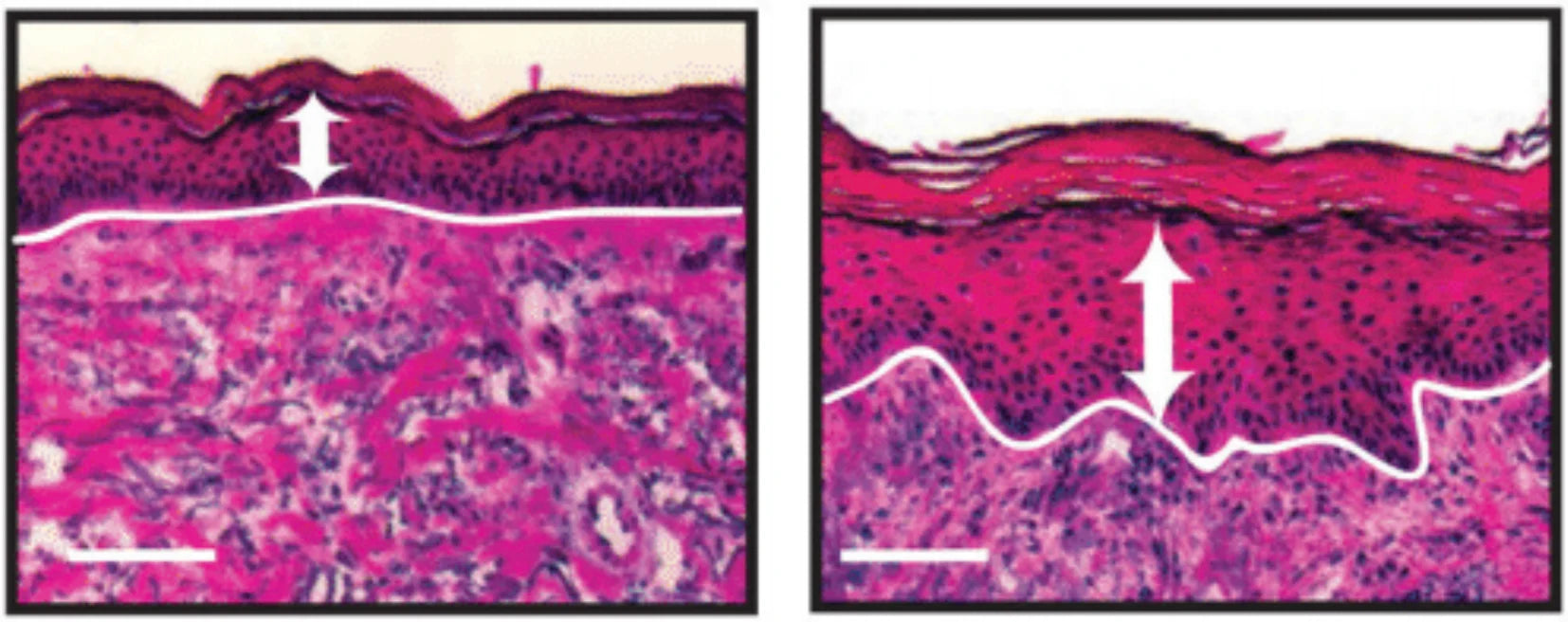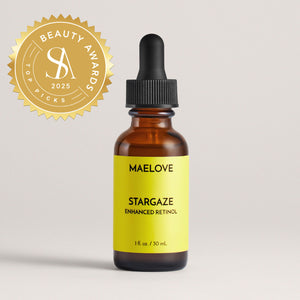Today, we're going to show you many pictures and images, so that you can see (and not just read about) the fascinating molecular and cellular transformations that occur when you introduce retinoids to your skincare routine.
In a 2017 study by Shao and colleagues from the University of Michigan, the effects of 0.4% retinol on skin were investigated over a period of seven days. Let's break down their findings and understand each step of the process.
Welcome to part two of our deep dive into retinoids!

This research by Shao's team was conducted in vivo, meaning it was carried out on living humans. This approach is distinct from in vitro studies, which are performed in test tubes or culture dishes outside a living organism.
The study's participants were individuals with an average age of 76 years, allowing the researchers to examine the impact of retinoids on aging skin.
Through a controlled experiment, the researchers sought to isolate the specific effects of retinoids on the skin, providing valuable insights into how these compounds benefit our skin at the molecular and cellular levels.
In this study, the researchers developed two identical topical formulations with just one key difference between them.
One formula contained 0.4% retinol, while the other had 0% retinol. The latter is known as the "control vehicle" or simply "vehicle."
You can think of this experiment as a face-off between retinol and no retinol, aiming to determine which provides more significant skin benefits.
As a result, you'll often see side-by-side images like these. Keep in mind that these are not before-and-after comparisons. Instead, they demonstrate the differences between two distinct treatments: one with retinol and the other without it, the control vehicle, which we'll refer to as "NO RETINOL."

Now, let's dive deeper into the findings. The images presented are from skin samples obtained through punch biopsies after seven days of treatment.
These skin samples were specially stained to emphasize particular components the researchers wanted to examine, resulting in the striking pink and blue colors you see.
SEE: Topical retinol promotes the formation of new skin cells and blood vessels, which leads to overall rejuvenation of the skin.
Figure 1 Part A shows skin tissue that went under what’s called H&E staining, which stands for hematoxylin and eosin staining.

What you observe is a significant enhancement in the epidermis thickness after just seven days of retinol treatment.
In Figure 1B, the bar graph explicitly illustrates the increase in skin thickness, measured in micrometers. As shown, the epidermal thickness was, on average, 2.1 times thicker with RETINOL compared to NO RETINOL (the control vehicle). This improvement is highly beneficial since the skin tends to thin as we age, making it more susceptible to injuries.

Next, in Figure 1C, Shao and colleagues used staining techniques to highlight the presence of Ki67 protein in the skin samples.
Ki67 is frequently employed as a marker to gauge the extent of cell proliferation, which refers to a cell's growth and subsequent division into two new cells.
In essence, a higher presence of Ki67 signifies increased cell generation activities. It is clearly visible that there's a greater amount of Ki67 staining in the retinol-treated samples compared to those without retinol.

In their observations, Shao and colleagues discovered that retinol treatment led to a 12-fold increase in the number of Ki67 positive cells in the epidermis. Additionally, there were substantially more Ki67 positive cells in the dermis with retinol, compared to none in the control group.

This provides clear evidence that retinol is stimulating the production of more skin cells. This is beneficial because a thicker skin layer offers better protection against potential injury.
BTW - Don't worry, when we say "thicker skin," we don't mean rougher or tougher skin, like callouses. Instead, by "thicker," we're referring to skin that is more supple and resilient.
Interestingly, one type of cell that retinoids promote the growth of in the skin are endothelial cells, which form blood vessels. So in image 1G, Shao and colleagues specifically stained the skin tissue to highlight endothelial cells.

As you can observe, there are significantly more endothelial cells with retinol.
Indeed, one of the major benefits of topical retinoids is the increase in blood vessels and improved blood flow to the skin.
In image 1G, the researchers measure this angiogenesis – the formation of new blood vessels – which reveals an impressive 3.8-fold increase with retinol.

In conclusion, from Figure 1, we can see that topical retinol promotes the formation of new skin cells and blood vessels, which leads to overall rejuvenation of the skin.
SEE: Topical retinol boosts the levels of procollagen, fibronectin, and tropoelastin in the skin, leading to firmer and bouncier skin.
Moving on, Shao and colleagues stained the skin samples for Type 1 procollagen, fibronectin, and tropoelastin.
These proteins provide firmness to your skin, and their levels decrease as you age, resulting in wrinkles and sagging skin. Increasing these proteins is crucial for combating fine lines, wrinkles, and maintaining skin elasticity and bounce.
In Figure 2A, the staining for Type I Procollagen is visible. It's evident that there is a significant increase in procollagen production in the skin treated with retinol.

In fact, the amount of procollagen was three times greater with retinol treatment. Higher levels of procollagen lead to increased collagen production, which is beneficial for maintaining skin firmness and elasticity.

I strongly recommend checking out our Deep Guide to Collagen for more background information. You can find it here.
Type 1 collagen serves as the main structural protein for your skin, acting like tent poles to support the skin's overall structure. And below, you'll find an image of collagen fibers as seen under an electron microscope.

Following up with Figure 2C, the researchers quantified the increase in fibronectin. Although this protein isn't discussed as frequently, it plays a vital supporting role.
Fibronectin is a glycoprotein that binds to other proteins, including collagen, to help provide adhesion and structure to the skin. And here you can see fibronectin content is also boosted by retinol treatment.

In Figure 2E, the researchers stained the skin samples for tropoelastin, which is the precursor to elastin, much like procollagen is a precursor to collagen.
Elastin is a stretchy protein similar to the material in your leggings. Within the skin, elastin imparts bounciness and resilience.
As seen under a microscope, elastin appears like stretchy netting wrapped around collagen fibers. Retinol treatment also leads to an increase in tropoelastin content, further enhancing the skin's elasticity.

The researchers discovered that retinol treatment led to a four-fold increase in tropoelastin content compared to the skin without retinol. This is a remarkable improvement, especially considering it was achieved after just one week of treatment.

In conclusion, Figure 2 demonstrates that retinol boosts the levels of procollagen, fibronectin, and tropoelastin in the skin. Having higher amounts of these crucial proteins helps maintain skin that is firmer and more resilient.
SEE: Topical retinoids help preserve collagen
Moving on to Figure 5 of the study, this section features images captured using atomic force microscopy, which can provide resolution as precise as fractions of a nanometer. For context, a nanometer is incredibly small – a sheet of printer paper is about one hundred thousand nanometers thick. So, these images offer an extremely close-up view of the skin samples.
In Figure 5, we see magnified images of collagen fibers from the skin samples obtained from the study participants, who had an average age of 76 years old.

As you get older, collagen fibers become more susceptible to damage and degradation. This is evident in the image on the left, where the fibers appear worn and mangled.
In contrast, the image on the right, which shows skin treated with retinol, displays long, intact, and healthy collagen fibers. Retinol appears to have a positive impact on maintenance of the skin's collagen structure.

In Figure 5B, Shao and colleagues presented 3D visualizations of the same images. Once again, it is evident that the collagen fibers in the skin treated with retinol are much smoother and intact compared to the untreated skin.
Retinoids seem to play a significant role in maintaining the structure and integrity of collagen fibers. In other words, retinoids help preserve the collagen you have longer.

In discussing Figure 1, we saw how retinol increases procollagen production, which is the starting building material that eventually becomes mature and intact collagen fibers. As skin ages, not only does procollagen production decrease, but the existing collagen fibers degrade more quickly as well (which is a double whammy of bad news).
Figure 5 demonstrated that with retinol treatment, you can better maintain your deposits of mature and intact collagen fibers. And as you know, more collagen means fewer wrinkles.
We hope you enjoyed our exploration of Shao and colleagues' research. Keep in mind that these noticeable improvements at the molecular and cellular level occurred after just seven days of treatment with a 0.4% retinol serum. Clinical studies suggest that it may take eight weeks for these microstructural changes to translate into visible improvement.
However, if you could see inside your cells, you'd find that the benefits are happening very soon after starting treatment. So, be sure to use your retinoids consistently and be patient. The real secret to maintaining great skin long term is consistency in sticking to a good routine.
That's it for today's blog post, part two of our deep dive into retinoids (You can find part one here.). In part three, we'll try to answer the question: which retinoid is the best—retinol, retinal (retinaldehyde), or tretinoin (retinoic acid)?
Related Products
Maelove Moonlight Retinal Super Serum (for those who have tried retinoids before)
Maelove Stargaze Retinol Serum (for retinoid newbies)
References
Shao Y, He T, Fisher GJ, Voorhees JJ, Quan T (2017). “Molecular basis of retinol anti-aging properties in naturally aged human skin in vivo.” International Journal of Cosmetic Science. 39(1): 56-65.
Uitto J, Olsen DR, Fazio MJ (1989). “Extracellular Matrix of the Skin: 50 Years of Progress.” 92 (4): S61-S77.


